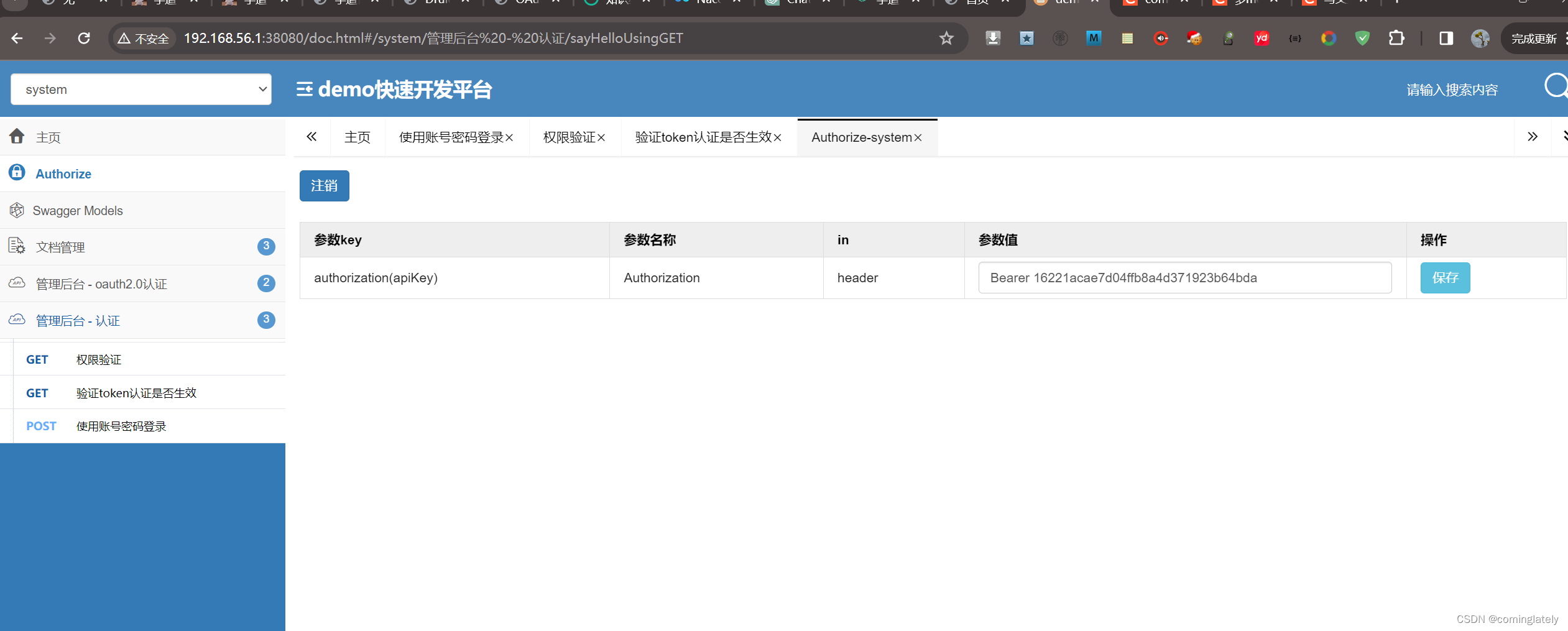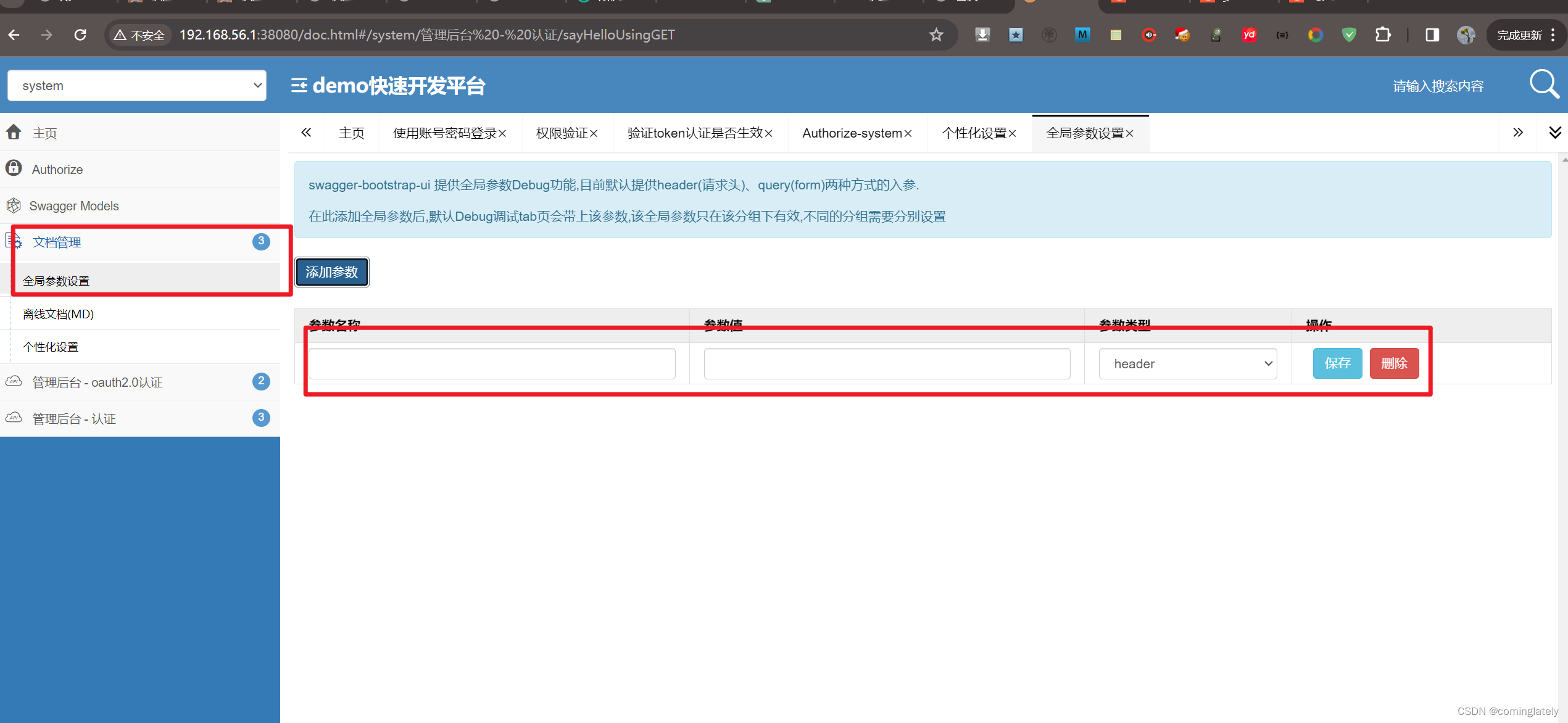场景
项目使用swagger提供接口文档功能, 下面演示下多module的springboot 项目是怎么配置
效果

分析
- 通过为每个module设置独立的分组,完成分组切换功能, 下面举个例子
@EnableSwagger2
public class SwaggerConfig {
@Bean
public Docket group1Api() {
return new Docket(DocumentationType.SWAGGER_2)
.groupName("Group1")
.apiInfo(apiInfo())
.select()
.apis(RequestHandlerSelectors.basePackage("com.example.group1"))
.paths(PathSelectors.any())
.build();
}
@Bean
public Docket group2Api() {
return new Docket(DocumentationType.SWAGGER_2)
.groupName("Group2")
.apiInfo(apiInfo())
.select()
.apis(RequestHandlerSelectors.basePackage("com.example.group2"))
.paths(PathSelectors.any())
.build();
}
private ApiInfo apiInfo() {
return new ApiInfoBuilder()
.title("Your API Title")
.description("Your API Description")
.version("1.0.0")
.build();
}
}
- 项目使用了spring security 所以需要有设置Authorization Header的位置,这可以通过2种方式实现
2.1 Docket.securitySchemes方法,入参是ApiKey列表
2.2 通过编辑"文档管理 -> 全局参数设置完成"

实现
- 引入依赖
<!-- 1. swagger-bootstrap-ui 目前改名为 knife4j -->
<!-- 2. 实现 swagger-bootstrap-ui 的自动化配置 -->
<!-- 3. 因为 knife4j-spring 已经引入 Swagger 依赖,所以无需重复引入 -->
<dependency>
<groupId>com.github.xiaoymin</groupId>
<artifactId>knife4j-spring</artifactId>
</dependency>
<dependency>
<groupId>com.github.xiaoymin</groupId>
<artifactId>knife4j-spring-ui</artifactId>
</dependency>
- swagger配置
/**
* @version V1.0
* @author: carsonlius
* @date: 2023/12/28 10:07
* @company
* @description swagger配置
*/
@AutoConfiguration
@ConditionalOnProperty(prefix = "springdoc.api-docs", name = "enabled", havingValue = "true", matchIfMissing = true)
@EnableConfigurationProperties(SwaggerProperties.class)
@EnableSwagger2
public class DemoSwaggerAutoConfiguration {
/**
* 设置system分组
* */
@Bean
public Docket createSystemApi(SwaggerProperties properties) {
return new Docket(DocumentationType.SWAGGER_2)
.groupName("system")
// 设置api信息
.apiInfo(apiInfo(properties))
// 扫描;controller包路径, 获取api接口
.select()
.apis(RequestHandlerSelectors.basePackage("com.carsonlius.module.system"))
.paths(PathSelectors.any())
// 构建Docket对象
.build()
.securitySchemes(Collections.singletonList(apiKey()));
}
/**
* 设置system分组
* */
@Bean
public Docket createWebApi(SwaggerProperties properties) {
return new Docket(DocumentationType.SWAGGER_2)
.groupName("web")
// 设置api信息
.apiInfo(apiInfo(properties))
// 扫描;controller包路径, 获取api接口
.select()
.apis(RequestHandlerSelectors.basePackage("com.carsonlius.framework.web"))
.paths(PathSelectors.any())
// 构建Docket对象
.build()
.securitySchemes(Collections.singletonList(apiKey()));
}
/**
* 设置请求头
* */
private springfox.documentation.service.ApiKey apiKey() {
return new springfox.documentation.service.ApiKey("authorization", "Authorization", "header");
}
/**
* 创建API信息
* */
public ApiInfo apiInfo(SwaggerProperties swaggerProperties) {
return new ApiInfoBuilder().title(swaggerProperties.getTitle())
.description(swaggerProperties.getDescription())
.version(swaggerProperties.getVersion())
.contact(new Contact(swaggerProperties.getAuthor(), swaggerProperties.getUrl(), swaggerProperties.getEmail()))
.build();
}
}
- security配置
对swagger请求放行
.antMatchers("/swagger-ui.html", "/webjars/**", "/v2/api-docs", "/swagger-resources/**").permitAll()
// 设置具体请求的权限
httpSecurity.authorizeRequests()
.antMatchers(HttpMethod.GET, "/*.html", "/**/*.html", "/**/*.css", "/**/*.js").permitAll() // 静态资源无需认证
.antMatchers("/websocket/message").permitAll() // websocket无需认证
.antMatchers("/swagger-ui.html", "/webjars/**", "/v2/api-docs", "/swagger-resources/**").permitAll()
// 放行 Druid 监控的相关 URI
.antMatchers("/druid/**").permitAll()
.antMatchers(HttpMethod.GET, permitAllUrlMap.get(RequestMethod.GET).toArray(new String[0])).permitAll()
.antMatchers(HttpMethod.POST, permitAllUrlMap.get(RequestMethod.POST).toArray(new String[0])).permitAll()
.antMatchers(HttpMethod.PUT, permitAllUrlMap.get(RequestMethod.PUT).toArray(new String[0])).permitAll()
.antMatchers(HttpMethod.DELETE, permitAllUrlMap.get(RequestMethod.DELETE).toArray(new String[0])).permitAll()
.and().authorizeRequests().anyRequest().authenticated(); // 其他请求必须认证
@ConfigurationProperties 注解
SwaggerProperties 通过@ConfigurationProperties将配置属性影射到ConfigurationProperties对象。 这个注解一般配合@EnableConfigurationProperties使用,或者直接在ConfigurationProperties上加上@Component





















 1983
1983











 被折叠的 条评论
为什么被折叠?
被折叠的 条评论
为什么被折叠?








